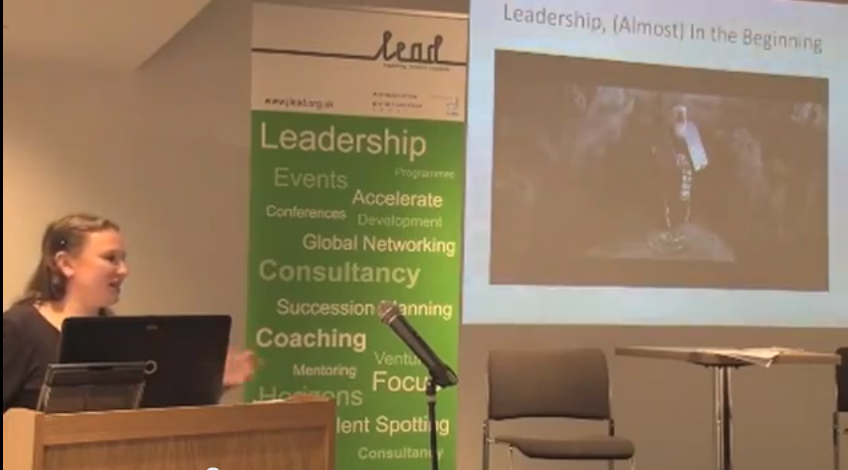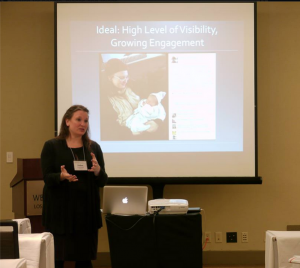Social Media Society

Kicking off January With “Jewish Geography Goes Digital”
0Mid-January arrived, and with it, the RAVSAK/PARDES Jewish educators’ conference – titled “Moving the Needle,” the content contained inspiring speakers, informative panels, deep dives into practical subject matters and workshops designed to give educators a skills upgrade. I was honored to present “Jewish Geography Goes Digital” to an involved and inquisitive group of Jewish educators from across the country – the interactive skills session featured extensive dialogue with those in the room, facilitated sharing of experience using social media in an educational context, and the introduction of new tools and awareness of social media culture as a way to deepen relationships with constituents.
You can check out my presentation below (and additional presentations are available here). And remember, if you’re interested in a consultation on social media culture or tools, creative content strategy, or communications methods for the digital age, please be in touch and we can discuss the possibilities.

Video Workshop: “Leadership in the Digital Age”
0 In May, I was invited to London to speak as part of the Jewish Leadership Council’s Lead Division’s newest initiative, Leading In which was created in response to the desire and need for more leadership skills training, expressed by alumni of Lead’s programmes as well as employers within the community. The JLC, in a blog post about the program, explained:
In May, I was invited to London to speak as part of the Jewish Leadership Council’s Lead Division’s newest initiative, Leading In which was created in response to the desire and need for more leadership skills training, expressed by alumni of Lead’s programmes as well as employers within the community. The JLC, in a blog post about the program, explained:
We believe that Jewish communal leaders need both a deep understanding and knowledge of the UK Jewish Community as well as a core range of leadership skills. Leading In consists of regular bi-monthly evening sessions, open to all who are in a leadership position in the community, both lay and professional. Each session will include a leadership skills based session (a choice of three with the option to participate in a fundraising series over several sessions), an opportunity to network and a masterclass with an inspirational, visionary leader.
The event, held at the London Jewish Museum, was attended by 60 lay and professional leaders from more than 30 Jewish communal organizations. Debbie Klein, chair of JW3 (the about-to-launch Jewish Community Centre), gave the opening keynote discussing leadership tips, and participants chose from workshops like, “Inside the mind of a leader” with Jeff Wolfin, “Fundraising” with Jeff Shear (the second in the series), and my session, “Leadership in the Digital Age: Conversing, Commenting and Creating Meaningful Relationships” (available in its entirety – 1 hour, 22 minutes – below.
“Leadership in the Digital Age” – Esther Kustanowitz, May 2013
Crash Course: 7 Tips Toward Strengthening Media Strategy
0
Over the years, I’ve had a number of people – at the office and in other areas of my life – ask for my advice on everything from PR to online content development and social media engagement. Most of them are just looking to glean some quick advice. So I thought it might be helpful to share a few pieces of advice about media strategy and PR. (A version of this post originally appeared on my blog, My Urban Kvetch.)
For a more comprehensive assessment of your current media strategy, or to work on particular elements of your media outreach, my consulting services are available at reasonable rates.
7 Tips Toward Strengthening Media Strategy
Whether you’re promoting an event that’s happened, or doing strategic outreach to bolster audience support, here are 7 basic elements to consider and tips to keep in mind:
1. Content: It’s cliched to say that content is king, but content is the storytelling core of your strategy. The content will create a connection – intellectual or emotional – to the work you do. Make your first sentence engaging, and give the reader something they can’t find anywhere else. This means not recycling the two paragraphs you’ve used in promoting the event or experience – it’s the story of that event or experience: why is it important, what is the backstory, which fascinating folks are involved…take the reader behind the scenes and give insider information that only attendees would have experienced. Begin with a killer sentence – a riveting question or a surprising quote – once you get people hooked, they’ll read on to find out more about what that first intriguing sentence means.
2. Length: Unless your Communications Department instructs you otherwise, I suggest a length of 400 words (maximum) for blog posts. Originally, about 400 words was be the maximum that would appear on a computer screen. Computers (and screen fonts) come in all sizes these days, but with the human attention span being fragmented, keeping it short and riveting is still a solid strategy. It also keeps you on track, making sure you use words and quotes that count, and helps increase the chance that people will read to the end.
3. Timing: If there’s a fast turnaround needed for a blog post the morning after an event, the best way to do it is to pre-write the bulk of it. This may sound dishonest, but PR people do it all the time – they create skeleton posts with all the stuff that you know ahead of time and is not going to change (the where, what, who, when and why). Then leave spaces for things that personalize the experience and paint “what really happened in the room” – quotes from speakers or attendees, surprises in terms of attendees or reactions or questions, details of the kinds of discussions and partnerships that ensued. The next day, fill in the blanks, massage the language so it doesn’t seem like a composite post, and you’ll have a compelling, authentic post, posted in record time. People will marvel at your efficiency, and you don’t have to reveal this secret to anyone. 🙂
4. Tone: Keep the “inside scoop” approach in mind when writing – so it’s not just “this happened, and it brought a lot of things together, and it was interesting,” but really capture the feel of who was there, how they were connecting with the speaker or presentation, and report some of the more interesting comments that go a little deeper and tell a better story than “this was a great event and I hope to attend another one soon.” The “insider info” approach is like crack to people who write and read blogs – even though it’s a calculated strategy, it’s still authentic and special, and that’s what people want. Depending on your organization’s tone, you may opt for more or less formal, but the voice should be factual, authoritative and relatable.
5. Images: Any photos accompanying online content should be dynamic. People sitting at tables is one of the least compelling images you can submit. Get up close, take “action photos” – smiling attendees having animated conversations goes a long way image-wise. And if you have access to photos taken by participants, ask participants if you can use their photos – that’s another opportunity for engagement, and it might also help you share the event’s story digitally.
6. Distribution: When the post goes live, do not depend on your Communications or PR department alone to distribute it. This is your work. You know where your audience lives, so make sure they see it by Tweeting, FBing and promoting it in your enewsletters. Send to your “superusers” who have wide networks and are fluent in social media – they’ll help the post get seen.
7. Social media strategy: Social media should be part of the discussions early and often – as you’re visualizing an event or initiative, integrate social media into that plan – it will help you later. Do you have other tips to recommend? Feel free to leave them in the comments section.
Want to drill deeper? Let’s set up a business call to talk. And in the interim, happy content-ing!

“Is the Facebook IPO Good for the Jews?” – Jewish Telegraphic Agency
0 In light of the recent IPO by social media juggernaut Facebook, the Jewish Telegraphic Agency asked me some questions about how the Jewish community uses Facebook in a piece titled “Is the Facebook IPO Good for the Jews?”
In light of the recent IPO by social media juggernaut Facebook, the Jewish Telegraphic Agency asked me some questions about how the Jewish community uses Facebook in a piece titled “Is the Facebook IPO Good for the Jews?”
The piece was picked up in a number of other locations, including The Jewish Journal and Ha’aretz.

Virgin Atlantic’s Snowpocalypse Social Media #Fail
1When a blizzard prompted the cancellation of hundreds of flights on December 26 of last year, I was scheduled to be on VS004 from JFK to London. My Virgin Atlantic flight – which had been cancelled on the 19th due to a blizzard at Heathrow and rescheduled for the 26th at 6:05pm – was again cancelled after we sat on the plane for two hours because of a blizzard at JFK, was rescheduled for 6:05pm the 27th, then delayed to 7:30, then to a boarding time of 8:15 that didn’t happen, and eventually, after great protest from the passengers, finally took off after midnight on the 28th. During the entire experience, Virgin Atlantic continued to answer questions on its @virginatlantic Twitter account – except about our flight. There was no “stay tuned,” no “sorry we don’t have more information right now,” just silence. This is unacceptable in a social media world.
Nearly a month later now, Virgin Atlantic still denies that passengers were due any compensation for the experience, even as JetBlue once again proves its VIP status by giving their stranded passengers 10,000 points, scoring customer satisfaction points among its inconvenienced passengers. When it comes to all-star VIP customer treatment and stellar social media response, JetBlue turns around their bad situation, resulting in another social media win. In other words, JetBlue was able to take a blizzard and turn it into snowcones.
What’s the problem? Why won’t Virgin Atlantic make any compensation to the 250 of us who were on VS 004? According to USA Today, Virgin Atlantic (via spokesperson Greg Dawson) claims that “monetary compensation is not due” to the people on our flight – who “had to sleep in the airport terminal because all hotels nearby were booked” – because the snowstorm was an “extraordinary occurrence.” (The Virgin Atlantic staff also told us that the hotels they were offering us were two hours away in Long Island, and that buses would take too long to reach us, collect us and turn around and go back to Long Island.)
Travel writer and the main Twitter voice of our Virgin Atlantic experience Jason Cochran hasn’t given up on the idea of compensation, and continues to battle the customer relations and public relations departments via email.
But apparently, Virgin’s petulant behavior extends far beyond our particular flight – according to Bnet’s Brett Snyder, “Virgin Atlantic has decided it won’t pay Heathrow Airport’s owner BAA anything until an inquiry into last month’s days-long shutdown is completed. Virgin Atlantic is acting like an impatient child here, and runs the risk of making relations with its most important airport even worse.”
This preposterous experience just doesn’t seem to end. And least of all for writers. Because Jason is still on this situation – it’s his job to be. And as for me, while I’m not spending every day fighting about it, I definitely have more to say. Because all the elements of this experience combined into something resembling a psychological experiment in how far people’s patience can be stretched before someone cracks and goes postal. And while a Tweet here and there might not have alleviated our discomfort as we lay down for 40 minutes’ rest on the cold floor of JFK Airport, Virgin Atlantic should have been using its social media presence to reassure us, to apologize to us, and to make us feel accompanied on our difficult travel. That kind of attention could really have helped us feel like we hadn’t been quite so abandoned.
Here endeth the lesson. Except not quite, because Virgin Atlantic hasn’t learned anything.

Twitter and the College Student Population
0 At the recent JFNA General Assembly in New Orleans, I was asked to speak to a group of student journalists for a program called “Do the Write Thing.” The program features speakers from the world of Jewish leadership as well as from Jewish journalism – the session that I co-headlined (with the Jewish Agency’s Florence Broder) was about social media’s role in today’s Jewish journalism. While all of the students understood and used Facebook, and a few of them were familiar with blogs and the concept of blogging, when it came to Twitter, many of them were clueless. One of the attendees, a writer for the Binghamton University Pipe Dream, wrote a piece for that paper and noted that a junior, double-majoring in history and philosophy, politics and law, “stared blankly when asked about Twitter. ‘I barely know what it is,’ she said. ‘Something about birds?’”
At the recent JFNA General Assembly in New Orleans, I was asked to speak to a group of student journalists for a program called “Do the Write Thing.” The program features speakers from the world of Jewish leadership as well as from Jewish journalism – the session that I co-headlined (with the Jewish Agency’s Florence Broder) was about social media’s role in today’s Jewish journalism. While all of the students understood and used Facebook, and a few of them were familiar with blogs and the concept of blogging, when it came to Twitter, many of them were clueless. One of the attendees, a writer for the Binghamton University Pipe Dream, wrote a piece for that paper and noted that a junior, double-majoring in history and philosophy, politics and law, “stared blankly when asked about Twitter. ‘I barely know what it is,’ she said. ‘Something about birds?’”
While the students in the room at DTWT weren’t quite at that level of Twitter illiteracy, their lack of facility – and maybe even interest? – in the tool known as Twitter illustrates a point. Not every person who is young is active in all forms of social media. And while Facebook may be an exception, there is no one social media tool that is being used actively by all young people.
What organizations can take away from this is that although young people are involved in social media, social media is not the universal tool through which a project or organization can reach all young people. Today’s organizations must be educated about the tools that are out there, and know how to use them – but organizations need to adopt flexibility in creating their social media strategies, matching the available time and energy of their staffs to the likely payoff in each of the markets for tools like Twitter, Facebook, LinkedIn, etc.
Social media consultants can help, but so can members of your target demo. Use the tools that are out there – search Twitter and Facebook for conversations relevant to your product or program. And convene focus groups of people in the relevant demo – ask them how they prefer to get information and how they use these tools. Once you know where the people you want to reach dwell, you can know how to knock on the door.
“Globalizing the Shtetl” Presentation Now on SlideShare
0I gave this presentation, “Globalizing the Shtetl,” at the 2010 Jewish Communal Professionals of Southern California Conference, held October 28, 2010 in Malibu, CA.

Your “Twimprimatur,” and Other Secrets of Social Media
0 What’s a Twimprimatur? Here’s a hint: I made it up. And here’s another hint: imprimatur + Twitter. (Imprimatur literally means “let it be printed,” but here are some more definitions.)
What’s a Twimprimatur? Here’s a hint: I made it up. And here’s another hint: imprimatur + Twitter. (Imprimatur literally means “let it be printed,” but here are some more definitions.)
In July, I was interviewed by Rusty Mike Radio in Jerusalem – we went deep into blogging, Twitter, Facebook, and more. Check out the entire interview here, for insights into making these social media work better for you, as well as stories about Jewish innovation, how to make blogging into a quasi-career, and what my connection is to Madonna. And, of course, how to create your own Twimprimatur. 🙂
“Disconnect to Connect” – Unplugging for the Sabbath
0The Jewish Standard recently asked for my comments about whether people are too technology-reliant these days, and how it can impact Jewish connections and community.
People first used e-mail, for example, to keep in touch with others they wouldn’t otherwise reach, Kustanowitz said.
“It was a way to mass-produce these kinds of communications that were still about continuing a relationship and adding value to a relationship,” she said.
Such developments have led to what Kustanowitz called an over-reliance on technology, without a sense of deliberation or thought. Just as Jews are supposed to have a certain amount of kavanah, intent, when they pray, she said, so, too, should people have a sense of kavanah when sending out e-mail and posting to social networking Websites.
To read the entire article, visit the Jewish Standard online.



